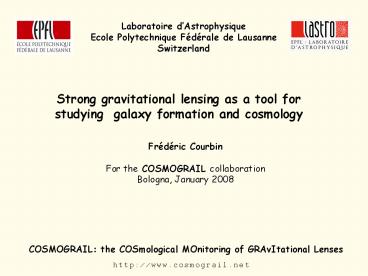Astrophysique I: introduction - PowerPoint PPT Presentation
Title:
Astrophysique I: introduction
Description:
Detailed HST-NICMOS (F160W) imaging (from CASTLE) ... (Eigenbrod et al. 2006, A&A 451, 747; data from CASTLEs) Going beyond HST resolution: ... – PowerPoint PPT presentation
Number of Views:45
Avg rating:3.0/5.0
Title: Astrophysique I: introduction
1
Laboratoire dAstrophysique Ecole Polytechnique
Fédérale de Lausanne Switzerland
Strong gravitational lensing as a tool for
studying galaxy formation and cosmology
Frédéric Courbin For the COSMOGRAIL
collaboration Bologna, January 2008
COSMOGRAIL the COSmological MOnitoring of
GRAvItational Lenses
http//www.cosmograil.net
2
Quasar time delays, H0 and galaxy mass profile
Geometry (plus Ho)
Radial (mass) profile of the lens
3
Quasar time delays, H0 and galaxy mass profile
- Quasar lensing requires
- High-accuracy astrometry (a few milli-arcsec)
- Detailed mapping of the light distribution in the
lens - Image of the lensed host galaxy of the quasar
- Accurate measurement the time delays
- Image deconvolution of HST images is extensively
used but - Lack of PSF stars in the small HST field of view
- PSF distortions across the field
- Colour dependence of the PSF
HST
Ground
4
Example of a lensed quasar RX J1131-123
HST / ACS
1.2 m Euler (La Silla)
3 arcsec
(Sluse et al. 2006, AA 449, 539, including data
from CASTLEs)
5
COSMOGRAIL telescopes
Liverpool 2m Robotic Telescope
Euler (Chile) Mercator (La Palma) 2 x 1.2m
telescopes
Uzbek 1.5m Telescope
2m Himalayan Chandra Telescope
Switzerland G. Meylan F. Courbin C. Vuissoz A.
Eigenbrod G. Burki D. Sluse P. Saha
Belgium P. Magain V. Chantry E. Eulaers L. Le
Guillou H. Van Winckel C. Waelkens
India T. Prabhu D. Sahu C.S. Stalin
UK S. Dye S. Warren
Uzbekistan M. Ibrahimov I. Asfandiyarov
6
WFI 2033-4723
Rather wide angular separation (2-3
arcsec) Photometry using MCS deconvolution
(Magain, Courbin, Sohy, 1998, ApJ 494, 472)
1.2 m Euler (deconvolved) image FWHM 0.35 arcsec
HST ACS image (from CASTLEs)
7
WFI 2033-4723
219 epochs ! Sampling 4 days 3 full years
Vuissoz et al. 2008
8
WFI 2033-4723
Time delays measured from 3 different methods
(Vuissoz et al. 2008) B-A 35.5 1.4 days
(3.8), most of the error is shot noise B-C
63.7 3.4 days (5.0), most of the error comes
from systematics Slow microlensing is
negligible, fast microlensing (scales of weeks)
is not.
9
WFI 2033-4723
Shifted curves
Vuissoz et al. 2008
10
WFI 2033-4723
- Detailed HST-NICMOS (F160W) imaging (from
CASTLE) - Light profile of the lens (best fit de
Vaucouleurs) - Astrometry to 3 mas accuracy including
systematics - Faint Einstein ring
11
WFI 2033-4723
Ingredients for the modeling G1 and G2, plus
group, plus external shear
12
WFI 2033-4723
Non parametric modeling
Twisting of the mass contours Dynamical
perturbation from group ?
13
WFI 2033-4723
- Twisted mass iso-contours, suggesting
gravitational perturbation - When the time delays are not fitted, all models
agree with the - data isothermal, de Vaucouleurs, NFW
- When the time delays are used, the best mass
model is a central - de Vaucouleur plus NFW dark matter halo
- The twisting of the mass contours and the steep
mass profile of - the lens in WFI 2033-4723 suggest the lens is a
satellite rather - than a central galaxy of a group.
14
Going beyond HST resolution
- An iterative PSF construction algorithm is
devised - Start with a TinyTim PSF (Krist Hook)
- Carry out a first deconvolution
- Remove extended sources in the image
- Estimate a new PSF on the point sources in the
data - Deconvolve again
- Do this a few times until the residuals are
acceptable
Magain, Courbin, Gillon, et al. 2007, AA 461,
373 Chantry Magain 2007, AA 470, 467
-gt For more details
15
Going beyond HST resolution
Example of application to NICMOS images of the
cloverleaf
Original F160W image
16
Going beyond HST resolution
Example of application to NICMOS images of the
cloverleaf
Modifications applied to the PSF after each
deconvolution step
Chantry Magain 2007, AA 470, 467
17
Going beyond HST resolution
Example of application to NICMOS images of the
cloverleaf
New résolution is 0.05 arcsec
Chantry Magain 2007, AA 470, 467 ( see poster)
18
Going beyond HST resolution the double Einstein
ring in SDSS 092402
Deconvolved
HST (F555WF814WF160W)
(Eigenbrod et al. 2006, AA 451, 747 data from
CASTLEs)
19
- For the concordance cosmology lenses appear to
split in two groups - isothermal lenses
- lenses with a steeper-than-isothermal inner (15
kpc) mass profile - Most lenses are in groups, often dominated by a
brighter member. - Numerical simulations show that galaxies in
groups, that have steep mass profiles are
satellite galaxies, and that the steep profile is
transient (e.g. Dobke, King Fellhauer 2007). - -gt The time delay technique allows to infer the
details of the inner - structure of galaxies in a range of
environments - -gt Estimate Ho independent of standard candles by
stacking lenses - -gt provided there exist sufficiently high
resolution images to - interpret the time delays
20
COSMOGRAIL papers so far
- I Simulated light curves
- Eigenbrod et al. 2005, AA 436, 25
- II The double Einstein ring in SDSS J092402
- Eigenbrod et al. 2006, AA 451, 747
- III Deep VLT spectroscopy of 7 lensed quasars
- Eigenbrod et al. 2006, AA 451, 759
- IV Non parametric modeling of cosmograil
objects - Saha et al. 2006, AA 450, 461
- V First time delay measurement
- Vuissoz et al. 2007, AA 464, 845
- IV Deep VLT spectroscopy of 8 lensed quasars
- Eigenbrod et al. 2007, AA 465, 51
- VII First high-accuracy time delay (3)































